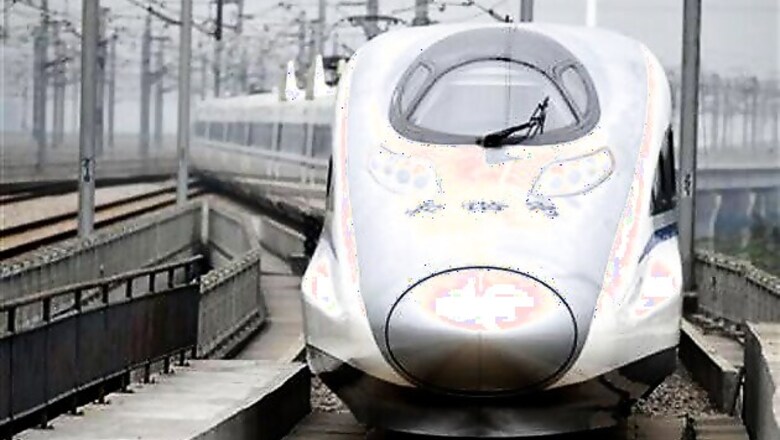
views
The proposal for developing High Speed Railway (HSR) between Delhi and Kanpur via Agra was first mooted in the mid-eighties when Madhavrao Scindia was the railway minister. An internal study found the proposal unviable at that time due to the high cost of construction and inability of travelling passengers to bear much higher train fares than what was for normal trains. Railways then settled for Shatabdi trains, fast inter-city day trains generally travelling at a maximum speed of 130 kilometres per hour, though Bhopal Shatabdi has a maximum speed of 150 kilometres per hour between New Delhi and Agra. While we are still discussing pros and cons of developing HSR in the country, Chinese Railways who began planning for HSR in the mid-nineties, started construction in 1998 and now have the largest HSR network in the world, over 7000 route kilometres. Recently Chinese Railways signed an MOU with Indian Railways for technical cooperation including HSR technology and also showed interest to construct HSR in India.
The introduction of HSR is opposed on the grounds that they are expensive, and they can wait for some more years till the paying capacity of the people increases considerably to afford it. It is also argued that middle level speed up to 180/200 kilometres per hour on existing lines would be adequate for India as it is cost-effective and more energy-efficient than HSR.
Although High Speed Railways were built in Europe and Japan for carrying people for generally a distance up to 500/700 kilometres, China is constructing a high speed rail network for the entire country. Recently Chinese Railways have introduced high speed trains covering a distance of 2400 kilometres in eight hours. Imagine covering a distance between Chennai and Delhi in about 7 hours and from Delhi to Mumbai in less than 5 hours. This kind of travel experience will be a game changer and alter the way business and trade is conducted in the country. Drastic reduction in the transit time as compared to conventional railways, providing greater convenience and travel comforts with stations located in city centres, and being comparatively more energy efficient than air in terms of per passenger kilometre giveHSR an edge over all the transport modes including air travel.
The high speed rail changes the entire game of passenger transport. With provision for fast and frequent rail travel, business activity gets a boost. HSR requires much less land for construction as compared to expressways and highways. A two line HSR is generally equivalent to eight lane highways for creating capacity for passenger transport. As a result, building HSR is more beneficial from the sustainability point of view because it saves land and reduces energy usage and carbon emission.
The introduction of High Speed Rail in India is mentioned in the Railway Vision 2025 where it was stated that Indian Railways would develop six corridors in four regions. Railways have commissioned pre-feasibility studies for all the possible corridors and these are at different stages of completion.
Despite mention in the Railway Vision 2025, Indian Railways have been very cautious about committing on developing HSR in India. The Working Group for the Twelfth Plan for Railways has emphasised on increasing commercial speeds and augmenting trains as the thrust areas for passenger business. The Working Group has suggested setting up High Speed Rail Authority for developing HSR and for constructing one HSR corridor during the Plan Period. However, actual materialisation will depend up on fund availability; the preferred mode for which is Public Private Participation.
There is a high degree of enthusiasm in different states for high speed corridors. Some of the state governments have commissioned their own pre-feasibility studies on potential corridors with high traffic demand. Kerala has planned a HSR from Thiruvananthapuram to Mangalore in Karnataka. Maharashtra may like to introduce HSR from Mumbai to Nagpur apart from the Pune-Mumbai-Ahmedabad corridor which has been put on fast track by the Central government. Tamil Nadu has envisaged a HSR corridor connecting Chennai, Coimbatore, Madurai and Kanya Kumari in 'Vision Tamil Nadu 2023' released this year. Karnataka wants a HSR from Bangalore to Mysore and also from Bangalore to Belgaum and Gulbarga.
A strong political will is needed to get HSR in the country. Such capital-intensive projects can be built either entirely with government funding as being done by China or a very sizable viability gap funding from the government. In the current times where there is terrible shortage of supply to meet passenger transport demand, developing High Speed Rail network in the country will be the right step towards sustainable development.
Shri Prakash is Distinguished Fellow at The Energy and Resources Institute (TERI).




















Comments
0 comment